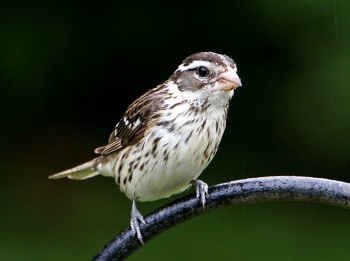- Pheucticus ludovicianus
Identification
8" (20 cm) Starling-sized
Heavy pinky-white bill
Male:
- Black and white
- Pinkish-red patch on breast and underwings
Female:
- Brownish upperparts
- Whitish underparts with heavy brown streaking
- Prominent white supercilium
- Yellow wing linings
Distribution
Eastern Canada and US; winters from Mexico to Peru and western Cuba
Taxonomy
This is a monotypic species[1].
Habitat
Moist woodlands close to open fields with tall shrubs; also old and overgrown orchards.
Behaviour
Breeding
The nest can be found in a low tree branch. The clutch consists of 4 or 5 purple-spotted whitish eggs which are laid in a loosely made nest of twigs, grass, and plant fibers.
Diet
A large part of its diet consists of potato beetles and larvae as well as weed seeds, wild fruits, and buds.
Vocalisation
Call: its distinctive call note is a sharp, penetrating, metallic eek-eek
Song: is like that of an American Robin, but softer and more melodious.
References
- Clements, J. F., T. S. Schulenberg, M. J. Iliff, D. Roberson, T. A. Fredericks, B. L. Sullivan, and C. L. Wood. 2018. The eBird/Clements checklist of birds of the world: v2018. Downloaded from http://www.birds.cornell.edu/clementschecklist/download/
Recommended Citation
- BirdForum Opus contributors. (2025) Rose-breasted Grosbeak. In: BirdForum, the forum for wild birds and birding. Retrieved 17 May 2025 from https://www.birdforum.net/opus/Rose-breasted_Grosbeak
External Links
GSearch checked for 2020 platform.1






